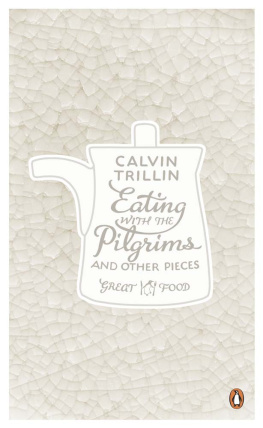Eating with the Pilgrims and Other Pieces
CALVIN TRILLIN
PENGUIN BOOKS
PENGUIN BOOKS
Published by the Penguin Group
Penguin Books Ltd, 80 Strand, London WC2R 0RL, England
Penguin Group (USA) Inc., 375 Hudson Street, New York, New York 10014, USA
Penguin Group (Canada), 90 Eglinton Avenue East, Suite 700, Toronto, Ontario, Canada M4P 2Y3 (a division of Pearson Penguin Canada Inc.)
Penguin Ireland, 25 St Stephens Green, Dublin 2, Ireland
(a division of Penguin Books Ltd)
Penguin Group (Australia), 250 Camberwell Road, Camberwell, Victoria 3124, Australia
(a division of Pearson Australia Group Pty Ltd)
Penguin Books India Pvt Ltd, 11 Community Centre, Panchsheel Park, New Delhi 110 017, India
Penguin Group (NZ), 67 Apollo Drive, Rosedale, Auckland 0632, New Zealand
(a division of Pearson New Zealand Ltd)
Penguin Books (South Africa) (Pty) Ltd, 24 Sturdee Avenue, Rosebank, Johannesburg 2196, South Africa
Penguin Books Ltd, Registered Offices: 80 Strand, London WC2R 0RL, England
www.penguin.com
This collection published in Penguin Books 2011
Copyright Calvin Trillin, 1977, 1980, 1981, 1990, 1996, 2000, 2002, 2003, 2010
All rights reserved
Cover design based on traditional Japanese crackle-glaze plates. (Photograph copyright Alamy.) Picture research by Samantha Johnson. Lettering by Stephen Raw
Except in the United States of America, this book is sold subject to the condition that it shall not, by way of trade or otherwise, be lent, re-sold, hired out, or otherwise circulated without the publishers prior consent in any form of binding or cover other than that in which it is published and without a similar condition including this condition being imposed on the subsequent purchaser
ISBN: 978-0-14-196707-3
PENGUIN BOOKS GREAT FOOD
Eating with the Pilgrims and Other Pieces
CALVIN TRILLIN (1935 ) is an American journalist, humorist and novelist. Born in Missouri, he joined the New Yorker in 1963. His reporting there has concentrated on America, between the coasts. For fifteen years, he produced an article from somewhere in the country every three weeks, on subjects that ranged from the murder of a farmers wife in Iowa to the authors efforts to write the definitive history of a Louisiana restaurant called Didees or to eat an awful lot of baked duck and dirty rice trying.
Sources
An Attempt to Compile a Short History of the Buffalo Chicken Wing, copyright 1980 by Calvin Trillin, originally appeared in The New Yorker. Eating With the Pilgrims, copyright 1981 by Calvin Trillin, originally appeared in The Nation. Stalking the Barbecued Mutton, copyright 1977 by Calvin Trillin, originally appeared in The New Yorker. Just Try It, copyright 1982 by Calvin Trillin, originally appeared in The New Yorker. Talk About Ugly, copyright 1990 by Calvin Trillin, originally published through King Features Syndicate. Missing Links, copyright 2002 by Calvin Trillin, originally appeared in The New Yorker. Lo Mein Lust, copyright 1996 by Calvin Trillin, originally appeared The New Yorker. The Magic Bagel, copyright 2000 by Calvin Trillin, originally appeared in The New Yorker. Killer Bagels, copyright 1996 by Calvin Trillin, originally appeared in The New Yorker. Dont Mention It, copyright 2002 by Calvin Trillin, originally appeared in The New Yorker. Wheres Chang?, copyright 2010 by Calvin Trillin, originally appeared in The New Yorker. Whats Happening to Brie and Chablis?, copyright 2003 by Calvin Trillin, originally appeared in The New Yorker.
An Attempt to Compile a Short History of the Buffalo Chicken Wing
I did not truly appreciate the difficulties historians must face regularly in the course of their research until I began trying to compile a short history of the Buffalo chicken wing. Since Buffalo chicken wings were invented in the recent past, I had figured that I would have an easy task compared to, say, medievalists whose specialty requires them to poke around in thirteenth-century Spain and is not even edible. My wife, Alice, I must say, was unenthusiastic about the project from the start. It may be that she thought my interest in pure research could lead me into searching out the origins of just about any local specialty I might contemplate eating too much of how the cheesesteak got to Philadelphia, for instance, or why Tucson is the center of interest in a Mexican dish called chimichanga, or how people in Saginaw came to begin eating chopped-peanuts-and-mayonnaise sandwiches, or why a restaurant I once visited in the market area of Pittsburgh serves sandwiches and french fries with the french fries inside the sandwiches. I assured her that I had no intention of extending my inquiries as far as chopped peanuts or interior french fries, although I couldnt fail to point out that she had, in a manner of speaking, expressed some curiosity about the Pittsburgh sandwich herself (Why in the world would anybody do such a thing?).
I saw the history of the Buffalo chicken wing as a straightforward exercise, unencumbered by the scrambled folk myth that by now must be part of the trimmings of something like the Philadelphia cheesesteak. There happens to be extant documentation identifying the inventor of Buffalo chicken wings as the late Frank Bellissimo, who was the founder of the Anchor Bar, on Main Street the form of the documentation being an official proclamation from the City of Buffalo declaring July 29, 1977, Chicken Wing Day. (WHEREAS, the success of Mr. Bellissimos tasty experiment in 1964 has grown to the point where thousands of pounds of chicken wings are consumed by Buffalonians in restaurants and taverns throughout our city each week ) I would not even have to rummage through some dusty archive for the document; the Anchor Bar has a copy of it laminated on the back of the dinner menu.
I had the further advantage of having access to what people in the history game call contemporary observers a crowd of serious chicken-wing eaters right on the scene. A college friend of mine, Leonard Katz, happens to be a Buffalonian a native Buffalonian, in fact, who became a dean at the medical school of the State University of New York at Buffalo. I have also known his wife, Judy, since long before the invention of the chicken wing. She is not a native Buffalonian, but she carries the special credentials that go with having been raised in New Haven, a city that claims to have been the scene of the invention of two other American specialties the hamburger and the American pizza. Although Leonard Katz normally limits his chicken-wing consumption to downing a few as hors doeuvres a policy, he assured me, that has no connection at all with the fact that his medical specialty is the gastrointestinal tract the rest of the family think nothing of making an entire meal out of them. Not long before I arrived in Buffalo for my field work, Linda Katz had returned from her freshman year at Washington University, in St. Louis a city where, for reasons I do not intend to pursue, the local specialty is toasted ravioli and headed straight for her favorite chicken-wing outlet to repair a four-month deprivation. A friend of Lindas who returned from the University of Michigan at about the same time had eaten chicken wings for dinner four nights in a row before she felt fit to carry on. Judy Katz told me that she herself eats chicken wings not only for dinner but, every now and then, for breakfast a pattern of behavior that I think qualifies her as being somewhere between a contemporary observer and a fanatic.





